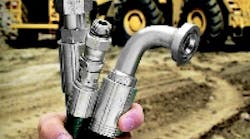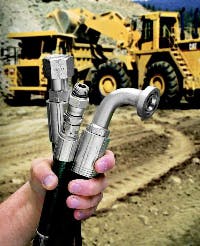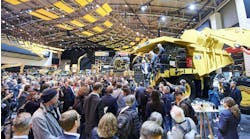- Correct size — both ID and length
- Adequate rated working pressure
- Tube stock to accommodate the hydraulic fluid
- Cover stock to resist the environment
- Reinforcement to withstand crushing, pinching, extreme suction, and other forms of abuse
- End connections, recommended for the hose, that are compatible with the fluid and ambient environment
- Temperature of the material conveyed and cleaning temperature used on hose.
Select the right size
Most hydraulic hose is built to conform to Society of Automotive Engineers (SAE) requirements for size, tolerances, construction and minimum performance characteristics of each major hose type. SAE standard J517 provides general, dimensional and performance specifications for the 100R hose series, which are the most common hoses used in hydraulic systems, Table 1.
Some manufacturers have developed hose products that far exceed the performance and construction requirements of the SAE specifications. These include higher pressure and temperature capability, greater flexibility, and bend radii down to one-half that of SAE standards.
| Table 1: Descriptions of SAE 100R series hose | |
|
|
|
|
|
Steel wire reinforced, rubber covered hydraulic hose (one wire braid) Type A - Thick cover (skive type) Type AT - Thin cover (no-skive type) |
|
|
High pressure, steel wire reinforced, rubber covered hydraulic hose (two wire braid) Type A - Thick cover (skive type) Type AT - Thin cover (no-skive type) |
|
|
Double fiber braid (non-metallic), rubber covered hydraulic hose |
|
|
Wire inserted hydraulic suction hose |
|
|
Single wire braid, textile covered hydraulic hose |
|
|
Single fiber braid (non-metallic), rubber covered hydraulic hose |
|
|
Thermoplastic hydraulic hose Black Orange - non-conductive |
|
|
High pressure thermoplastic hydraulic hose Black Orange - non-conductive |
|
|
High pressure, four-spiral steel wire reinforced, rubber covered hydraulic hose Type A - Thick cover (skive type) Type AT - Thin cover (no-skive type) |
|
|
Heavy duty, four-spiral steel wire reinforced, rubber covered hydraulic hose Type A - Thick cover (skive type) Type AT - Thin cover (no-skive type) |
|
|
Heavy duty, Six-spiral steel wire reinforced, rubber covered hydraulic |
|
|
Heavy duty, high impulse, four-spiral wire reinforced, rubber covered hydraulic hose |
|
|
Heavy duty, high impulse, multiple-spiral wire reinforced, rubber covered hydraulic hose |
|
|
Polytetrafluorethylene (PTFE)-lined hydraulic hose, single-stainless steel braid Type A - Reinforced with a one braid of 303XX series stainless steel Type B - Same as Type A; includes electrically conductive inner tube |
|
|
Heavy duty, high impulse, multiple-spiral wire reinforced, rubber |
|
|
Compact high pressure, one- and two-wire reinforced rubber covered hydraulic hosecovered hydraulic hose |
|
|
Compact 21 MPa maximum operating pressure, one- and two-steel wire reinforced rubber covered hydraulic hose with smaller bend radius |
|
|
Compact 27.5 MPa maximum operating pressure, one- and two-steel wire reinforced rubber covered hydraulic hose with smaller bend radius |
| 1The number designation following the letter R does not identify the number of reinforcement layers, but rather the specific requirements of a type of hose. | |
When selecting a hose assembly, carefully measure the distance between the two ports of the components. Too long a hose can lead to it being severed or pinched by moving components of equipment. If the hose is too short, pressure contraction may cause it to stretch, leading to shorter service life. (Hose length can change +2%to -4% from fluid pressure cycles.) So allow for possible shortening of the hose during operation by making the hose lengths slightly longer than the actual distance between the two connections.
Hose OD is important when hose routing clamps are used, or when hoses are routed through bulkheads. Check individual hose specification tables for outer diameters in suppliers' catalogs.
Pressure capabilities
Most important in the hose selection process is knowing system pressure, including pressure spikes. Hose working pressure must always be considered greater than or equal to the maximum system pressure because pressure spikes that exceed the published working pressure will shorten hose life. When equipment has been modified to perform special operations, it is not uncommon for unanticipated spikes in hydraulic pressure to occur. As a general rule, apply a generous margin of safety when choosing hose to transmit pressurized hydraulic fluid. Typically, for dynamic hydraulic applications, the minimum burst pressure rating is four times that of the maximum working pressure rating.
It also is important to account for pressure drop that occurs between the inlet of a hydraulic hose and the outlet. The following conditions can affect the amount of pressure drop:
Friction — Fluid rubbing against the inner surface of the hose assembly creates friction. Higher friction increases pressure drop through the hose, as does higher fluid velocity.
Viscosity — If a fluid's viscosity is not correctly matched to the operating temperature range of the hydraulic system, maximum performance and component life will not be achieved.
Fluid temperature — Higher temperatures tend to reduce viscosity of hydraulic fluid. This lower pressure drop through the hose, but can degrade the lubricity of the fluid.
Couplings and adapters — Any change in bore or change in direction (such as with 45° or 90° elbows) can increase the amount of pressure drop.
Hose ID — For a given flow rate, the smaller the hose ID, the higher the fluid velocity. Likewise, for a given hose ID, a higher flow rate increases fluid velocity. As noted above, higher velocities result in greater pressure drop. Therefore, you can minimize pressure drop by specifying a hose with the largest ID that is practical.
Managing pressure drop is important when designing a hydraulic hose assembly that requires a specific output pressure to run equipment efficiently. This means the input pressure to the hose assembly must be equal to the output, plus the amount of pressure drop. For example, if a system requires 4000 psi, and you calculate pressure drop through a hose assembly to be 150 psi, fluid pressure entering the assembly would have to be 4150 psi.
Help in determining pressure drop is available from representatives of hose and coupling manufacturers. Be prepared to describe the type of application, fluid type and viscosity, fluid and ambient temperature, fluid flow rate, hose size and length, routing requirements, government and industry standards being met, and the number and type of fittings.
Material
Hose selection must ensure compatibility of the hose tube, cover, couplings, and O-rings with the fluid used. The characteristics shown in Table 2 are for some of the most common hose stocks. Consult the individual hose manufacturer's chemical resistance tables to determine hose compatibility.
| Table 2: Comparison of hose stock types | ||||||
| Chemical name |
|
|
|
|
|
|
| ASTM-SE designation |
|
|
|
|
|
|
| SAE J14 & SAE J200 |
|
|
|
|
|
|
| Flame resistance |
|
|
|
|
|
|
| Petroleum base oils |
|
|
|
|
|
|
| Diesel fuel |
|
|
|
|
|
|
| Resistance to gas permeation |
|
|
|
|
|
|
| Weather |
|
|
|
|
|
|
| Ozone |
|
Good for cover |
|
|
|
|
| Heat |
|
|
|
|
|
|
| Low temperature |
|
|
|
|
|
|
| Water-oil emulsions |
|
|
|
|
|
|
| Water-glycol emulsions |
|
|
|
|
|
|
| Diesters |
|
|
|
|
|
|
| Phosphate esters |
|
|
|
|
|
|
| Phosphate ester based emulsions |
|
|
|
|
|
|
Variables such as high temperature, fluid contamination, and concentration will affect the chemical compatibility of the tube and fluid. Most hydraulic hoses are compatible with petroleum-based oils, but new environmental fluids may present a problem for some hoses.
Caution also must be exercised in selecting hose for applications that require specialized oils or chemicals that could permeate can through the hose tube. Permeation can manifest itself as either blisters between the tube and cover, created by trapped liquid or gas, liquid on the surface of the cover, or the escape of the fluid or gas into the atmosphere.
Hybrid hose stocks
Tube and cover stocks may be upgraded to enhance performance. The hybridization of rubber and synthetic thermoplastic compounds into abrasion-resistant hydraulic hose offers several enhancements over traditional hose materials, such as Neoprene and Nitrile.
A primary cause of hose failure on fluid power equipment is cover abrasion resulting from cuts, friction caused by other moving parts, or from mechanical impacts. For example, changes in fluid pressure can cause hoses to either elongate or contract, depending on their construction. The elongation or contraction can cause the hose to repeatedly impact adjacent machine elements or other hoses that eventually will wear away the hose cover to expose the underlying reinforcement. Exposed hose reinforcement is susceptible to rust and accelerated damage leading to failure.
Hybridized covers made of thermoplastics have a slick surface with a low coefficient of friction. This results in a cleaner appearing cover that resists dirt and oil residues. Some abrasion-resistant hose covers-have been tested and found to last up to 300 times longer than standard rubber covers. This feature increases service life, lowers maintenance, and eliminates the need for costly hose protectors such as guards, sleeves, and bundling.
Also under development are elastomeric tubing compounds that are more readily compatible with a new generation of environmentally friendly hydraulic fluids and additives.
Choose the right connections
The couplingtohose interface must be compatible with the hose that is selected. Follow the hose manufacturer's coupling recommendations only. The proper mating thread end must be selected to ensure a leak-free seal can be made to mating components.
Coupling selection can be more complicated if the end connection undergoes a high degree of motion, vibration, or both. Split flange couplings — or other couplings that use an O-ring for sealing — perform well under vibration. Couplings that use O-rings also are preferred in applications that undergo extreme temperature fluctuations.
Threadless connectors are becoming an attractive zero-leak alternative to conventional threaded fittings commonly used in hydraulic systems. The male and female halves simply push together — without wrenches or special assembly tools — to form a leak-free connection.
Several manufacturers have introducedthreadless connectors that yield the performance of Oring seals, but eliminate the cost of O-ring installation for hydraulic systems with working pressures to 6000 psi. As with JIC fittings, these connectors also provide a metalto-metal seal, but they don't have to be tightened to a specific torque.
Threadless connectors are used at the hydraulic port or manifold on steering units, valve blocks, pumps and motors. They offer several key benefits to equipment manufacturers:
- leak-proof connections that reduce the cost of warranty claims and fluid leaks from equipment used in the environmentally sensitive applications
- easier, quicker connections that reduce assembly costs
- tactile feedback and visual confirmation that the connection has been made
- assurance that connections cannot be accidentally made with other threadless couplings
- easy serviceability, and
- easy replacement in the field with traditional and widely available threaded connectors.
Some types of threadless connectors eliminate the need for adapters, which not only saves space, but somewhat offsets the higher cost normally associated with these types of hose end fittings.
The biggest advantage of threadless connectors is the reduced time and expense needed to install hydraulic hose and tubing assemblies and a greater accessibility for subsequent maintenance.
Installations with conventional threaded fittings can take several minutes or even hours, and they are subject to leaks because of tightening inconsistencies and other variables. On the other hand, threadless connectors allow even confined, difficult-to-reach connections be completed in minutes.
Instead of screwing on the threaded connector and tightening it with a wrench, threadless connecting halves — the male end and the adapter — simply push together to form a leak-free connection. A snap ring positively engages the male and female halves, without any assembly tools, although some designs do require a special tool for removal.
Avoid using couplings and hoses from different manufacturers interchangeably. This is because different manufacturers use different materials, which can result in a variety of tube styles. SAE allows a wide range of materials. An improperly matched or coupled hose will likely fail, causing downtime and injury. Therefore it is important to follow only the crimp and assembly recommendations of the manufacturer of the products being used.
Temperature considerations
Fluid and ambient temperatures must be considered when selecting hose and couplings. The hose and couplings must be capable of withstanding both minimum and maximum temperatures of the system. All hoses are rated with a maximum working fluid temperature of 200° to 400° F. Using a hydraulic hose at a temperature of 18°F above maximum rated temperature of the hose may cut the hose life in half.
On the other hand, minimum temperature must also be considered. Depending on materials used, hose may accommodate temperatures as low as -65° F (Hytrel and winterized rubber compounds) or as high as 400° F (PTFE).
When hoses are exposed to high external and internal temperatures concurrently, there will be a considerable reduction in hose service life. Insulating sleeves can help protect hose from hot equipment parts and other high temperature sources that are potentially hazardous. In these situations, an additional barrier is usually required to shield fluid from a possible source of ignition.
For more information, visit www.gates.com/fluidpower or call (800) 777-6363.


